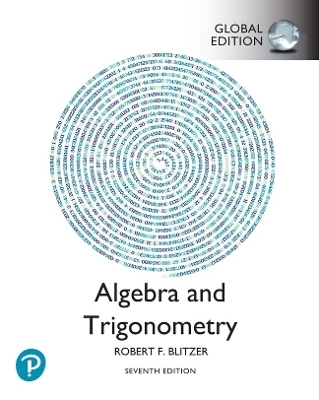
College Algebra
Pearson
978-0-13-511737-8 (ISBN)
- Titel erscheint in neuer Auflage
- Artikel merken
Mike Sullivan Professor of Mathematics at Chicago State University received a Ph.D. in mathematics from Illinois Institute of Technology. Mike has taught at Chicago State for over 35 years. He has been writing textbooks in mathematics for over 30 years. Mike has authored or co-authored over ten books. He is a native of Chicago’s South Side and currently resides in Oaklawn. He has four children: Kathleen, who teaches college mathematics, Mike III, who co-authors many titles as well as teaches college mathematics, Dan, who is a Prentice Hall sales representative, and Colleen, who teaches middle-school mathematics. Nine grandchildren round out the family. Why I Wrote This Book: As a professor of mathematics at an urban public university for over 35 years, I understand the varied needs of precalculus students who range from having little mathematical background and a fear of mathematics courses to those who have had a strong mathematical education and are highly motivated. For some of your students, this will be their last course in mathematics, while others may decide to further their mathematical education. I have written this text for both groups. As the author of precalculus, engineering calculus, finite math and business calculus texts, and, as a teacher, I understand what students must know if they are to be focused and successful in upper level mathematics courses. However, as a father of four, I also understand the realities of college life. I have taken great pains to insure that this text contains solid, student-friendly examples and problems, as well as a clear writing style. I encourage you to share with me your experiences teaching from this text. The eighth edition of this series builds upon a solid foundation by integrating new features and techniques that further enhance student interest and involvement. The elements of the previous edition that have proved successful remain, while many changes, some obvious, others subtle, have been made. A huge benefit of authoring a successful series is the broad-based feedback upon which improvements and additions are ultimately based. Virtually every change to this edition is the result of thoughtful comments and suggestions made from colleagues and students who have used the previous edition. I am sincerely grateful for this feedback and have tried to make changes that improve the flow and usability of this text.
TABLE OF CONTENTS
Chapter R Review
R.1 Real Numbers
R.2 Algebra Essentials
R.3 Geometry Essentials
R.4 Polynomials
R.5 Factoring Polynomials
R.6 Synthetic Division
R.7 Rational Expressions
R.8 nth Roots; Rational Exponents
Chapter 1 Equations and Inequalities 1.1 Linear Equations
1.2 Quadratic Equations
1.3 Complex Numbers; Quadratic Equations in the Complex Number System
1.4 Radical Equations; Equations Quadratic in Form; Factorable Equations
1.5 Solving Inequalities
1.6 Equations and Inequalities Involving Absolute Value
1.7 Problem Solving: Interest, Mixture, Uniform Motion, and Constant Rate Job Applications
Chapter 2 Graphs 2.1 The Distance and Midpoint Formulas
2.2 Graphs of Equations in Two Variables; Intercepts; Symmetry
2.3 Lines
2.4 Circles
2.5 Variation
Chapter 3 Functions and Their Graphs
3.1 Functions
3.2 The Graph of a Function
3.3 Properties of Functions
3.4 Library of Functions; Piecewise-defined Functions
3.5 Graphing Techniques: Transformations
3.6 Mathematical Models: Building Functions
Chapter 4 Linear and Quadratic Functions
4.1 Linear Functions and Their Properties
4.2 Building Linear Functions from Data
4.3 Quadratic Functions and Their Properties
4.4 Quadratic Models; Building Quadratic Functions from Data
4.5 Inequalities Involving QuadraticFunctions
Chapter 5 Polynomial and Rational Functions
5.1 Polynomial Functions and Models
5.2 Properties of Rational Functions
5.3 The Graph of a Rational Function
5.4 Polynomial and Rational Inequalities
5.5 The Real Zeros of a Polynomial Function
5.6 Complex Zeros: Fundamental Theorem of Algebra
Chapter 6 Exponential and Logarithmic Functions
6.1 Composite Functions
6.2 One-to-One Functions; Inverse Functions
6.3 Exponential Functions
6.4 Logarithmic Functions
6.5 Properties of Logarithms
6.6 Logarithmic and Exponential Equations
6.7 Compound Interest
6.8 Exponential Growth and Decay Models; Newton’s Law; Logistic Growth and Decay Models
6.9 Building Exponential, Logarithmic, and Logistic Functions from Data
Chapter 7 Analytic Geometry
7.1 Conics
7.2 The Parabola
7.3 The Ellipse
7.4 The Hyperbola
Chapter 8 Systems of Equations and Inequalities
8.1 Systems of Linear Equations: Substitution and Elimination
8.2 Systems of Linear Equations: Matrices
8.3 Systems of Linear Equations: Determinants
8.4 Matrix Algebra
8.5 Partial Fraction Decomposition
8.6 Systems of Nonlinear Equations
8.7 Systems of Inequalities
8.8 Linear Programming
Chapter 9 Sequences; Induction; the Binomial Theorem
9.1 Sequences
9.2 Arithmetic Sequences
9.3 Geometric Sequences; Geometric Series
9.4 Mathematical Induction
9.5 The Binomial Theorem
Chapter 10 Counting and Probability
10.1 Sets and Counting
10.2 Permutations and Combinations
10.3 Probability
Appendix Graphing Utilities
1 The Viewing Rectangle
2 Graphing Equations in Two Variables
3 Locating Intercepts and Checking for Symmetry
4 Solving Equations Using a Graphing Utility
5 Square Screens
6 Graphing Inequalities in Two Variables
7 Solving Systems of Linear Equations
8 Graphing a Polar Equation
9 Graphing Parametric Equations
| Erscheint lt. Verlag | 7.9.2009 |
|---|---|
| Sprache | englisch |
| Maße | 278 x 217 mm |
| Gewicht | 1768 g |
| Themenwelt | Mathematik / Informatik ► Mathematik ► Algebra |
| ISBN-10 | 0-13-511737-2 / 0135117372 |
| ISBN-13 | 978-0-13-511737-8 / 9780135117378 |
| Zustand | Neuware |
| Haben Sie eine Frage zum Produkt? |
aus dem Bereich

